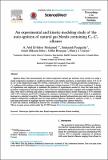| dc.contributor.author | Mohamed, Ahmed Abd El-Sabor | |
| dc.contributor.author | Panigrahy, Snehasish | |
| dc.contributor.author | Sahu, Amrit Bikram | |
| dc.contributor.author | Bourque, Gilles | |
| dc.contributor.author | Curran, Henry J. | |
| dc.date.accessioned | 2021-09-14T12:30:28Z | |
| dc.date.available | 2021-09-14T12:30:28Z | |
| dc.date.issued | 2020-07-16 | |
| dc.identifier.citation | El-Sabor Mohamed, A. Abd, Panigrahy, Snehasish, Sahu, Amrit Bikram, Bourque, Gilles, & Curran, Henry J. (2021). An experimental and kinetic modeling study of the auto-ignition of natural gas blends containing C1–C7 alkanes. Proceedings of the Combustion Institute, 38(1), 365-373. doi:https://doi.org/10.1016/j.proci.2020.06.015 | en_IE |
| dc.identifier.issn | 1540-7489 | |
| dc.identifier.uri | http://hdl.handle.net/10379/16954 | |
| dc.description.abstract | Ignition delay time measurements for multi-component natural gas mixtures were carried out using a rapid compression machine at conditions relevant to gas turbine operation, at equivalence ratios of 0.5–2.0 in ‘air’ in the temperature range 650–1050 K, at pressures of 10–30 bar. Natural gas mixtures comprising C1–C7 n-alkanes with methane as the major component (volume fraction: 0.35–0.98) were considered. A design of experiments was employed to minimize the number of experiments needed to cover the wide range of pressures, temperatures and equivalence ratios. The new experimental data, together with available literature data, were used to develop and assess a comprehensive chemical kinetic model. Replacing 1.875% methane with 1.25% n-hexane and 0.625% n-heptane in a mixture containing C1–C5 components leads to a significant increase in a mixture's reactivity. The mixtures containing heavier hydrocarbons also tend to show a strong negative temperature coefficient and two-stage ignition behavior. Sensitivity analyses of the C1–C7 blends have been performed to highlight the key reactions controlling their ignition behavior. | en_IE |
| dc.description.sponsorship | The authors would like to acknowledge Science Foundation Ireland for funding via project number16/SP/3829. We also acknowledge funding from Siemens Canada Ltd. | en_IE |
| dc.format | application/pdf | en_IE |
| dc.language.iso | en | en_IE |
| dc.publisher | Elsevier | en_IE |
| dc.relation.ispartof | Proceedings Of The Combustion Institute | en |
| dc.rights | Attribution 4.0 International (CC BY 4.0) | |
| dc.rights.uri | https://creativecommons.org/licenses/by/4.0/ | |
| dc.subject | Natural gas | en_IE |
| dc.subject | Ignition delay time | en_IE |
| dc.subject | Rapid compression machine | en_IE |
| dc.subject | Kinetic modeling | en_IE |
| dc.title | An experimental and kinetic modeling study of the auto-ignition of natural gas blends containing C1–C7 alkanes | en_IE |
| dc.type | Article | en_IE |
| dc.date.updated | 2021-09-13T15:23:41Z | |
| dc.identifier.doi | 10.1016/j.proci.2020.06.015 | |
| dc.local.publishedsource | https://doi.org/10.1016/j.proci.2020.06.015 | en_IE |
| dc.description.peer-reviewed | peer-reviewed | |
| dc.contributor.funder | Science Foundation Ireland | en_IE |
| dc.contributor.funder | Siemens Canada | en_IE |
| dc.internal.rssid | 26712132 | |
| dc.local.contact | Henry Curran, Dept Of Chemistry, Room 215, Arts/Science Building, Nui Galway. 3856 Email: henry.curran@nuigalway.ie | |
| dc.local.copyrightchecked | Yes | |
| dc.local.version | PUBLISHED | |
| nui.item.downloads | 67 | |


